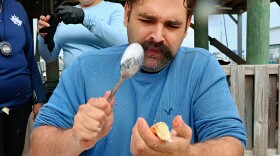Although the Atlantic hurricane season begins on June 1 st, the National Oceanic and Atmospheric Administration (NOAA), the National Weather Service (NWS) and the National Hurricane Center (NHC) use the months in between for critical research.
So what effect might a prolonged federal government shutdown have on hurricane forecasting and research?
“The off-season is the time of year when hurricane researchers do all their work to improve models for the coming season,” says Miami Herald environmental reporter Jenny Staletovich.
“In the last few years, the Hurricane Center has made a lot of progress in shrinking the 'cone of uncertainty' that shows where possible impacts from a storm might land. That work happens during the off-season -- during the [hurricane] season they're all too busy tracking storms," she says.
Most of the people at the National Hurricane Center in Miami are working through the shutdown. They're considered essential personnel so they're working without pay.
But Staletovich says NOAA, NWS and the National Hurricane Center rely on each other for gathering critical data. If research slows -- or stops altogether -- for one agency, it naturally affects the others. For example, work has been suspended on a NOAA hurricane intensity model that relies on a wide range of data coming in from ocean buoys, satellites and hurricane hunter airplanes.
The shutdown is also slowing efforts to fight a mysterious disease that's been destroying Florida's coral at an alarming rate.
Copyright 2020 WLRN 91.3 FM. To see more, visit WLRN 91.3 FM. 9(MDAyMTYyMTU5MDEyOTc4NzE4ODNmYWEwYQ004))








